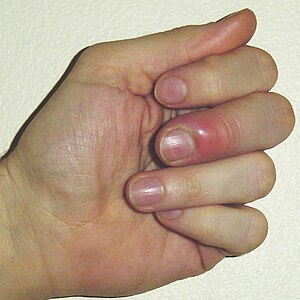Chronic paronychia
| Paronychia | |
|---|---|
 |
|
| Classification and external resources | |
| Specialty | Dermatology, emergency medicine |
| ICD-10 | L03.0 |
| ICD-9-CM | 681.02, 681.11 |
| DiseasesDB | 9663 |
| MedlinePlus | 001444 |
| eMedicine | derm/798 |
| MeSH | D010304 |
A paronychia (/ˌpærəˈnɪkiə/; Greek: παρωνυχία from para, "around" and onukh-, "nail") is a nail disease that is an often-tender bacterial or fungal infection of the hand or foot where the nail and skin meet at the side or the base of a finger or toenail. The infection can start suddenly (acute paronychia) or gradually (chronic paronychia). Paronychia is commonly misapplied as a synonym for whitlow or felon.
The skin typically presents as red and hot. These infections can be painful.
Pus is usually present, along with gradual thickening and browning discoloration of the nail plate.
Acute paronychia is usually caused by bacteria. Claims have also been made that the popular acne medication, isotretinoin, has caused paronychia to develop in patients. Paronychia is often treated with antibiotics, either topical or oral. Chronic paronychia is most often caused by a yeast infection of the soft tissues around the nail but can also be traced to a bacterial infection. If the infection is continuous, the cause is often fungal and needs antifungal cream or paint to be treated.
Risk factors include repeatedly washing hands and trauma to the cuticle such as from biting. In the context of bartending, it is known as bar rot.
Herpes whitlows are frequently found among dentists and dental hygienists. Prosector's paronychia is a primary inoculation of tuberculosis of the skin and nails, named after its association with prosectors, who prepare specimens for dissection. Paronychia around the entire nail is sometimes referred to as runaround paronychia.
...
Wikipedia
